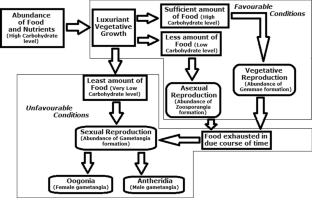Variability in reproductive morphology of family Saprolegniaceae and its significance
Review Articles | Published: 02 January, 2021
First Page: 1
Last Page: 12
Views: 4314
Keywords: Saprolegniaceae, Girishia indica , Morphological variability, Vegetative reproduction, Asexual reproduction, Sexual reproduction
Abstract
The family Saprolegniaceae includes 17 genera, viz., Achlya Nees von Esenbeck, Aphanodictyon Huneycutt ex Dick, Aphanomyces deBary, Aplanopsis Höhnk, Brevilegnia Coker & Couch, Calyptralegnia Coker, Couchia W.W. Martin, Dictyuchus Leitgeb, Geolegnia Coker, Leptolegnia deBary, Phragmosporangium Seymour, Plectospira Drechsler, Protoachlya Coker, Pythiopsis deBary, Saprolegnia Nees von Esenbeck, Sommerstorffia Arnaudow and Thraustotheca Humphrey. The eighteenth genus with its type species named—Girishia indica Prabhuji has been added to this list and has been critically discussed. Girishia indica Prabhuji has been found to be a connecting-link between family Pythiaceae and Saprolegniaceae. The morphological variability of reproductive structures (vegetative, asexual and sexual) in all eighteen members of Saprolegniaceae has been described and their significance has been discussed and reviewed.

References
- Bessey EA (1950) Morphology and taxonomy of fungi. Blakiston, United Kingdom
- Copeland HF (1956) The classification of lower organisms. Palo Alto, USA
- Johnson TW Jr (1956) The genus Achlya: morphology and taxonomy. University of Michigan Press, Ann Arbor
- Johnson TW Jr, Seymour RL, Padgett DE (2002) Biology and systematics of the Saprolegniaceae, http://www.ilumina-dlib.org
- Manton I (1952) The fine structure of plant cilia. Symp Soc Exp Biol 6:306
- Manton I (1965) Some phyletic implications of flagellar structure in plants. In: Preston RD (ed) Advances in botanical research, vol II. Academic Press, London
- Novaes-Ledieu M, Jimenez-Martinez A, Villanueva JR (1967) Chemical composition of hyphal wall of Phycomycetes. J Gen Microbiol 47:237
- Prabhuji SK (1979) Studies on some lower fungi occurring in certain soils of Gorakhpur, India. Ph.D. thesis approved by University of Gorakhpur, Gorakhpur
- Prabhuji SK (2005) Occurrence and phenology of the oomycetes with special reference to saprolegniaceae. In: Mukerji et al. KG (eds) Frontiers in Plant Sciences, International Pvt. Ltd., New Delhi, pp. 129–142
- Prabhuji SK (2010) Sexual reproduction in water moulds—I: general aspects related to family Saprolegniaceae. Int J Pl Reprod Biol 2(1):17–30
- Prabhuji SK (2011) The interdependence of watermoulds occurring in water and soil habitats affecting their population density, distribution and periodicity. Trop Ecol 52(3):311–324
- Prabhuji SK (2014) The pH mediated occurrence of watermoulds in soil habitat affecting their distribution. Elixir Appl Bot 67:21364–21368
- Prabhuji SK (2018) Water moulds form part of terrestrial ecosystem in a transition from aquatic to soil habitat. Clim Change Environ Sustain 6(2):89–98
- Prabhuji SK (2020) Watermoulds: heterotrophs that constitute significant part of aquatic ecosystem. RASSA J Sci Soc 2(1):34–40
- Prabhuji SK, Srivastava GK (2014) Occurrence of an Oömycete in water body of Gorakhpur, India with unusual affinities, Elixir Appl. Botany 67:21362–21363
- Seymour RL (1970) The genus Saprolegnia. Nova Hedwigia 19:1–122
- Sinha SK (1985) Studies in fungi causing fish diseases. Ph.D. thesis approved by the University of Gorakhpur, Gorakhpur
- Srivastava GC (1967) Some species of Saprolegniaceae collected from Gorakhpur, India. Hydrobiologia 30:281–292
- Srivastava RC (1979) Aphanomycosis—a new threat to fish population. Mykosen 22(1):25–29
- Turian G (1962) Cytoplasmic differentiation and dedifferentiation in the fungus Allomyces. Protoplasma 54:323
- Vogel HJ (1960) Two modes of lysine synthesis among lower fungi: evolutionary significance. Biochem Biophys Acta 41:172
- Wolf FT (1939) A study of some aquatic Phycomycetes isolated from Mexican soils. Mycologia 31:376–387
- Prabhuji SK (2013) Aquatic Oömycetology: a new field of research. The Botanica 62–63:27–43
Author Information
Biotechnology and Molecular Biology Centre, M.G. Post Graduate College, Gorakhpur, India